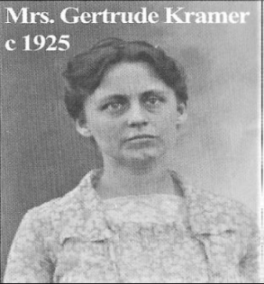View entry
Name: KRAMER, Henry Charles

Birth Date: 8 Sep 1886 San Fransisco
Death Date: 13 Sep 1957 Los Angeles
First Date: 1912
Profession: Missionary for South African Compound and Interior and other missions
Area: Bunyore (Kima)
Married: In Riverside, California Gertrude B. Bangham b. 19 Dec 1889 Liberty Township, Ohio, d. 2 Sep 1981 Covina, Los Angeles
Children: Gertrude Ellen (24 Feb 1913 Bunyore-8 Jan 1922 Los Angeles); Evalyn (29 Sep 1914 Bunyore-9 Feb 2001 Montebello, Calif.); Gladys (6 Jan 1917 Bunyore-7 Mar 1994 Covina, Los Angeles); Lois Vivian (23 May 1919 Bunyore-5 May 1923 Bunyore)
Book Reference: Red 25, Hut, Red Book 1912
General Information:
https://au-archives.hykucommons.org/downloads/f86da3cc-d986-4b7e-84cf-ee80c798447d?locale=en The Beginning of Church of God Missions in Kenya and the Early Missionaries who Served at Ingotse Mission Henry C. and Gertrude Kramer, former Friends missionaries, came to stay while they went on furlough. Mrs. Kramer translated the first gospels of Mark and John into the local language. Later the rest of the New Testament and Psalms was completed and published by the American Bible Society and received with great excitement by the people. In 1914 while the Kramers were at Kima, Mr. A. W. Baker and his daughter, Mabel, visited the mission, and Mabel remained to serve as a missionary and translator at Kima for the next 38 years. When the Kramers went on furlough, Mr. and Mrs. O. C. Keller took charge of the mission. About this time, Mr. A.W. Baker in South Africa, felt that he could no longer sponsor the additional mission in East Africa. He asked the Kramers, while they were on furlough, to look for a church group in America that would be willing to assume the responsibility of the mission in Kenya. Mr. Baker required that the organization 1.) should not stress “the speaking of tongues”, 2.) should teach the Bible as the Word of God, and 3.) should teach the unity of God’s people.
During their furlough in 1921, while the Kramers were visiting sponsors in Pomona, California, they met two brothers, Abram and William Bixler, of the Church of God. Already familiar with the Gospel Trumpet magazine, and impressed by the witness of the Bixlers, the Kramers embraced the truth of the teachings of the Church of God. When Mr. Kramer told about the offer made by A. W. Baker to obtain a new sponsor for the East African mission, William Bixler suggested that the Missionary Board of the Church of God should consider taking advantage of this opportunity. The Pomona congregation paid the train fare so that Henry and Gertrude Kramer could be in Anderson, Indiana to meet with the Missionary Board at the camp meeting in June. For the past eight years, Mr. Kramer had been in charge of the mission in British East Africa owned by Mr. A. W. Baker of the South African Compound and Interior Mission. He was able to give a detailed description of the mission and the work of evangelization and education being carried on there. Henry and Gertrude Kramer returned to Kima after their furlough and resumed their work among the Bunyore people. Mrs. Kramer was a talented teacher, having created a system of writing the local language and was producing school books. The Kramers endured many hardships including the death of two of their children. In her bereavement, Mrs. Kramer translated several hymns into the local dialect, which also comforted the African people in their difficult times. In 1923 Mr. Kramer laid the foundation for the big church on the mission. The work at Kima was expanding, and over the next several years the Samuel Joiners, John and Twyla Ludwig and many other dedicated missionaries would come to join the staff as they endeavored to meet the needs of the people living in the surrounding villages.
In addition to the evangelistic work at Kima, the missionaries were heavily involved in education. They started holding classes for boys and girls in separate schools, and taught sewing to women. They trained evangelists and teachers. Schools were also started in outlying villages directed and maintained by the African church. They cared for the sick who came for help.
